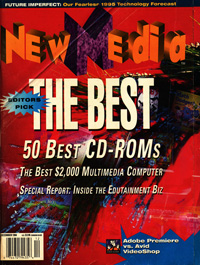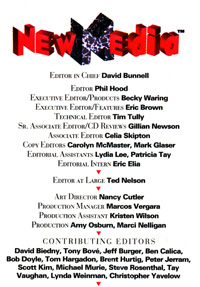|
Vaughan Family Timestream® Maps |
| Home Biography People Places Multimedia: Making It Work On the Water Writings/Presentations |
Ask the Captain
April, 1993
From "Ask the Captain," a monthly column by Tay Vaughan.
New Media Magazine.
Q. We are a small multimedia company starting our first serious cross-platform project, using Macromedia's Director and Windows Player. We have two Mac IIci's, a Mac Quadra 700, and one 486/33 PC, and we need to transfer movie and sound files as large as 15 MB, mainly from the Macs to the PC. How can we move these files, short of installing an expensive, full-bore server-based network?
-- Steve Wickler, Wellesley, MA
A. There are many methods for transferring files between Macs and PCs, including swapping diskettes and connecting the serial ports. But what you need for serious multimedia development (transferring the large files you have described qualifies yours as a serious project) requires both hardware and software. Grin and bear it: you must invest in the necessary "plumbing" or the "pipes" to move your data for this project. Indeed, you will quickly discover that this plumbing is as important as your choice of CPU!
With Director, you will be developing your project on the Mac, transferring converted .MMM files to the PC, testing them there, correcting them on the Mac in Director again, converting and transferring them to the PC again, then revising them yet again on the Mac, and transferring... This well-known development cycle demands a system that moves lots of data fast -- watching a progress dialog worm its way across your monitor pixel by pixel is a certain waste of your most valuable asset - time. You can also inflate tractor tires with a bicycle pump, but few do it.
While your Macintoshes (running System 7) are already equipped to provide LocalTalk network services without additional hardware or software, LocalTalk is too slow (230.4 kilobits per second) for the kind of "I need it now" transfers you will be doing, so you should go with Ethernet (10 megabits per second, or more than 40 times faster than LocalTalk). The Quadra has Ethernet built in; the CIs and PC will need add-on Ethernet boards (with street prices of about $200 each). You then connect all your computers with thick or thin Ethernet wiring, or, more commonly nowadays, with twisted pair wiring known as 10baseT. I was able to install Asante (800-662-9686) Ethernet cards in my Mac and PC in half an hour, and I used a separate hub adapter for the 10baseT wiring to avoid making up coaxial cables with BNC fittings.
Ethernet is only the system of pipes through which the data flows; you must also purchase software to control the flow of data. While software used in Ethernet networks (such as Netware or 3COM) has traditionally required a dedicated computer to act as a server for your network, there is a new generation of networking software that has you in mind!
Farallon (510-814-5000) has begun shipping a powerful new version of its Timbuktu cross-platform software for Macs and Windows that works without a file server (for about $160 per computer) and works with both LocalTalk and Ethernet. Timbuktu also lets you remotely access and control Macintoshes and PCs running Windows from anywhere on the network (it may startle you to see your Macintosh desktop on your PC monitor). TOPS from SunSelect (800-445-TOPS) also offers a peer-to-peer serverless networking solution for Macs, PCs, and Sun workstations (a 3-user pack for $299).
One caution: Avoid the painful darkness of interrupt and address purgatory during installation on your PC by choosing Ethernet boards that are supported by your software package. This is typically not a worry on the Macintosh side, because Mac Ethernet boards usually plug-and-play.
---
Q. I am wondering if there is any affordable hardware/software product available for my 486/33 PC that can allow me to overlay text and other special effects onto the input from my laserdisc player, VHS, or video recorder and then record that edited output to VHS (without any serious degradation to picture/sound quality)? I want to produce videotapes that combine computer graphics with real-time video.
-- Eric Stover, Tempe, Arizona
A. To edit video tape without degradation, and still be within "consumer" pricing, you should go with Hi-8 cameras and decks. Sony's Video System Control Architecture (VISCA) is a platform-independent command language that lets you control up to seven video peripherals through a V-Box (about $250) connected to the serial port of your PC. Sony's V-deck is a computer-controllable Hi-8 VCR (about $1800) that will allow you to do editing. On the PC, you will also need to install a video digitizing board like Cardinal's SnapPlus (about $850) that provides video-out.
For software video editing tools on the PC, look into Mathematica's Media Author ($799), a DOS-based multimedia authoring package that supports VISCA. Also for the PC, but more expensive, is Fast Electronics' Video Machine (about $4000) which includes both a digitizing board and award-winning software (New Product Award from the National Association of Broadcasters). Mathematica can be reached at 800-852-6284. Fast is at 508-655-FAST.
---
Q. At the high school where I work as an audio visual technician, we would like to control a NEC PC-VCR using an Amiga-based interactive system. We have been unable to find a driver for the Amiga; do you know who to contact about this?
-- Peter Jacobs, Winnetka, Illinois
A. Try Dave Mileusnich at NEC (708-860-9500). Tempus fugit: The PV-VCR system has been officially discontinued.
Send your questions to TAY c/o NewMedia, 901 Mariner's Island Blvd., Suite 365, San Mateo, Calif. 94404 or send a fax to (415) 573-5131. Writers of published questions will receive a NewMedia T-shirt and prompt answers to their questions.
Caption for attached figures: Farallon's Timbuktu software provides a simple method for exchanging files between Macs and PCs at Ethernet speeds. No dedicated server is required. but you will need Ethernet cards in your computers.

